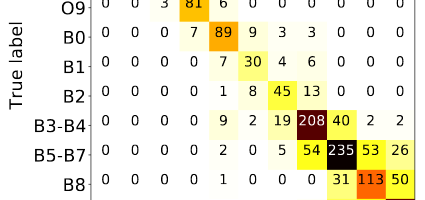A new automated tool for the spectral classification of OB stars
E. Kyritsis, G. Maravelias, A. Zezas, P. Bonfini, K. Kovlakas, P. Reig
(abridged) We develop a tool for the automated spectral classification of OB stars according to their sub-types. We use the regular Random Forest (RF) algorithm, the Probabilistic RF (PRF), and we introduce the KDE-RF method which is a combination of the Kernel-Density Estimation and the RF algorithm. We train the algorithms on the Equivalent Width (EW) of characteristic absorption lines (features) measured in high-quality spectra from large Galactic (LAMOST,GOSSS) and extragalactic surveys (2dF,VFTS) with available spectral-types and luminosity classes. We find that the overall accuracy score is ∼70% with similar results across all approaches. We show that the full set of 17 spectral lines is needed to reach the maximum performance per spectral class. We apply our model in other observational data sets providing examples of potential application of our classifier on real science cases. We find that it performs well for both single massive stars and for the companion massive stars in Be X-ray binaries. In addition, we propose a reduced 10-features scheme that can be applied to large data sets with lower S/N. The similarity in the performances of our models indicates the robustness and the reliability of the RF algorithm when it is used for the spectral classification of early-type stars. The score of ∼70% is high if we consider (a) the complexity of such multi-class classification problems, (b) the intrinsic scatter of the EW distributions within the examined spectral classes, and (c) the diversity of the training set since we use data obtained from different surveys with different observing strategies. In addition, the approach presented in this work, is applicable to data of different quality and of different format (e.g.,absolute or normalized flux) while our classifier is agnostic to the Luminosity Class of a star and, as much

